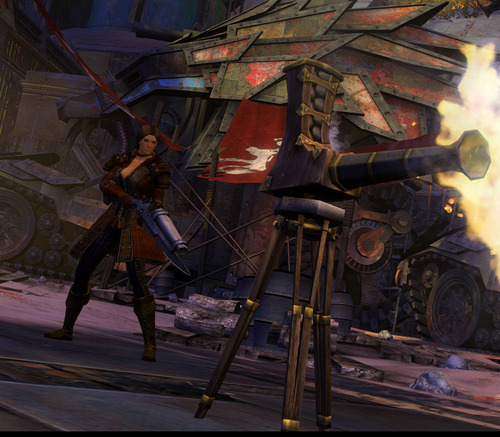Gender, Healing and Guild Wars 2: A Study Design
On Sunday, I posted a summary of my thoughts on some research that discussed whether people playing female avatars healed more than people playing male avatars.
TL; DR: I’m unconvinced that there is a causal connection in the “play a female avatar -> heal more” direction, and my experience with the genre suggests to me that there might be a “play a healer -> play a female avatar” causal relationship that could also account for the data. Therefore, it’s difficult for me to see a conclusive success in showing the Proteus Effect, which dictates that given an identity conflict, players conform their behavior to that of the identity of their avatar.
So how do we test that? The answer, as it so often is in my life, is Guild Wars 2.
GW2 got rid of the more traditional healer class in favor of a range of support skills that all characters can spec. There are classes that are more support-oriented (engineer comes to mind), but for the most part, healing and support in general are split across classes. So, Guild Wars 2 effectively removes the causal connection between “play a healer -> play a female avatar” because there are no healers. See the female engineer in the image below - definitely not a healer! (From the Guild Wars 2 website.)

So basically, running a similar study as Yee et al comparing player gender/avatar gender/damage dealt to hp healed in Guild Wars 2 could effectively eliminate the possibility that increased healing rates by female avatars are caused by the choice of the player to play a healer as female.
Healing in general in GW2 tends to be a less concrete decision then in previous MMOs. For example, as a level 80 thief, I can spec skills that help out allies, but rarely am I triggering them for that specific purpose. In the study of the Proteus Effect, it seems like players’ subconscious behavior and biases are what we want to find out – so the less concrete the action, the more useful.
GW2 might actually be a much better vehicle to study the Proteus Effect than World of Warcraft, where there’s all kinds of confounding factors about why characters choose to heal. A researcher might be able to mimic the GW2 kind of data by eliminating healers from the pool of characters studied in WoW, which seems kind of counterintuitive, but might help clarify the effects at work.
To be fair, studying GW2 in this way has a series of design considerations that would need to be taken into account. First, GW2, as far as I know, doesn’t have an equivalent of the WoW Armory (a central repository of all data about each character), so there are huge complicating factors in actually gathering the damage dealt vs. healing data that was relatively simple in WoW. But it seems likely that ArenaNet (the company that runs GW2) might be able to give data to an enterprising researcher.
GW2 also allows for a tremendous amount of flexibility in one’s spec – players can swap out skills so long as they aren’t in combat. However, the overall average of damage dealt to HP healed should allow for consistency here – since we’re only comparing characters to other characters. Assuming our sample size was large enough, we could also limit the study to something like structured PvP (Player vs. Player) or WvW (World vs. World), both parts of the game with more consistent rule sets than the more traditional Player v. Enemy), which would make the data more consistent.
The last and most unavoidable difference between studying GW2 and World of Warcraft is that they’re different games with different players. Data from one can’t really necessarily generalize to the other – as others have found with differences in game populations from EQ2 and WoW. However, I do think it would be interesting to see how the Proteus Effect plays out in a game where healing isn’t so much of a conscious class choice.
So, GW2 is the way to confirm the hypothesis that people playing female characters heal more than those playing male characters, without including stereotypes about the gender of healers. If it is in fact true that players, regardless of gender, heal more while playing a female avatar, that’s a powerful indication of social norms regarding women’s roles being internalized to the point where they transcend the consciousness of players and the boundaries of “real life.”